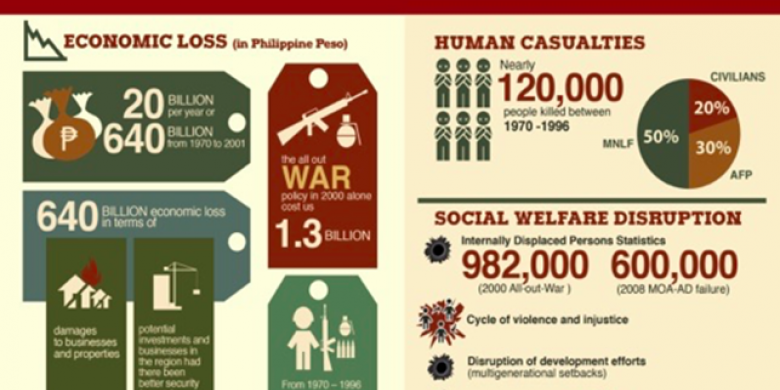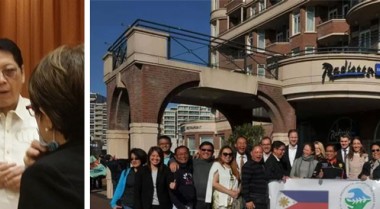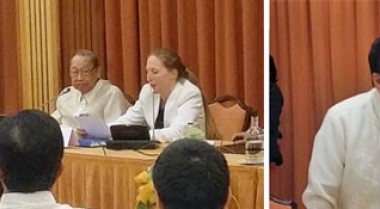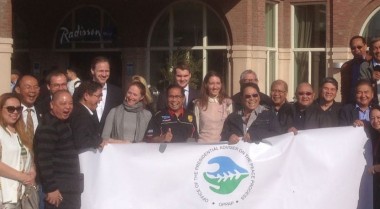
Interview: the Struggle for Peace in Mindanao, the Philippines
The southern Philippines has known a long history of armed conflict. Among those regions is Mindanao, where in February 2019 the Bangsamoro people voted to ratify the Bangsamoro Organic Law (BOL). This law is a big leap towards peace in the Southern Philippines. To understand why this is such a big leap for peace we interviewed Marc Batac, who is the Regional Programme Coordinator at our member organisation Initiatives for International Dialogue (IID) in the Philippines. IID has been involved in the peace process in Mindanao for almost twenty years.
To give us an overview of the conflict in Mindanao: how did the conflict come about, what are the root causes, who are the main actors and what is it about?
The root cause of armed conflict in Mindanao can be found in the narrative of Mindanao peoples’ continuing struggle for their right to self-determination. A struggle that involves an assertion of their identity and demand for meaningful governance in the face of the national government’s failure to realise genuine social progress and peace and development in the southern Philippines. The struggle is also a response to “historical injustices” and grave human rights violations committed against the peoples of Mindanao.
With the clamor to correct these historical injustices and to recognise their inherent right to chart their own political and cultural path, the Bangsamoro people – together with their non-Moro allies – have struggled to get their calls heard and acted upon by the central government.
With the clamor to correct these historical injustices and to recognise their inherent right to chart their own political and cultural path, the Bangsamoro people – together with their non-Moro allies – have struggled to get their calls heard and acted upon by the central government.
A huge number of the victims of the conflict in Mindanao have been ordinary civilians: women and men, young and old who were either displaced from their communities or killed in the crossfire by bullets and bombs that recognize no gender, religion, creed or stature.
There are two opposing views when it comes to the armed struggle in the Bangsamoro region: While the central government had earlier viewed the armed struggle as an act of rebellion against the state, the other party has always claimed it as a legitimate exercise of their right to self-determination.
Over the years, the State has come to recognise the Bangsamoro and Indigenous Peoples struggle for just and lasting peace in Mindanao, albeit always within the framework of the country’s constitution.
A huge number of the victims of the conflict in Mindanao have been ordinary civilians: women and men, young and old who were either displaced from their communities or killed in the crossfire by bullets and bombs that recognize no gender, religion, creed or stature. The impact and social cost of the decades-old war to the people and the entire nation have been vicious and costly. The infographic on the cost of war in Mindanao (see below) explains previous Philippine governments’ huge spending on wars in Mindanao, which clearly talks about ‘lives lost’ rather than ‘lives improved’. Finding peaceful solutions to the causes of the armed conflict in Mindanao is never easy as the toll has affected not just Mindanao but the entire country. This has discouraged foreign and local investments and ultimately bleeding the nation’s coffers with the previous governments spending more on war than on basic social services.
While previous governments tried to resolve these conflicts, the root cause is the failure to address the Mindanao peoples legitimate struggle for their ‘right to self-determination, dignity and governance’, and is a major challenge to achieving sustainable peace in the region.
The conflict between the Government of the Philippines and the armed groups in Mindanao, particularly the Moro Islamic Liberation Front (MILF), is not the only conflict affecting the whole region. The conflict in Mindanao is multi-faceted, involving numerous armed groups, as well as clans, criminal gangs and political elites. Main actors to this decades-old conflict are: the Moro Islamic Liberation Front (MILF), Moro National Liberation Front (MNLF) and other groups such as the Bangsamoro Islamic Freedom Fighters (BIFF), Abu Sayyaf (considered a bandit group engaged in various criminal activities like kidnapping and bombings), as well as other armed non-state actors who are consistently ‘in conflict’ with the central government.
While previous governments tried to resolve these conflicts, the root cause is the failure to address the Mindanao peoples legitimate struggle for their ‘right to self-determination, dignity and governance’, and is a major challenge to achieving sustainable peace in the region.

The Bangsamoro Organic Law (BOL) has been passed, which is for now the successful conclusion of a peace process. Can you explain what this is? And how it happened?
The purpose and intent of the law is to establish the new Bangsamoro political entity and provide for its basic structure of government. This also includes an expansion of the territory in recognition of the aspirations of the Bangsamoro people. Said law provides that the Bangsamoro Government will have a parliamentary form of government. The two key components of the peace process that will determine its eventual success are the passing of the BOL and the plebiscite for its ratification in the proposed Bangsamoro territory. With the BOL passage comes a roadmap that outlines a smooth transition leading to the creation of the Bangsamoro government that promises to fulfil the Bangsamoro’s aspirations for peace, justice, economic development and self-governance. The new Bangsamoro political entity will in effect abolish the Autonomous Region in Muslim Mindanao (ARMM) and provide for a basic structure of government in recognition of the justness and legitimacy of the cause of the Bangsamoro people and their desire to chart their own political future through a democratic process.
The BOL is a product not only of political negotiations between the Bangsamoro and the Philippine government through their respective principals and negotiators but of the peacebuilding community’s decades of peacemaking and conflict prevention work and initiatives, both inside and outside of Mindanao and the Philippines.
What has civil society, and particularly Initiatives for International Dialogue (IID), done for this peacebuilding process? And why is it important?
IID became more involved into the Mindanao peace process when then President Joseph Estrada unleashed an “all-out war” against the MILF in 2000 that resulted in countless deaths, wounded and massive dislocation of mainly Moro communities. IID’s Moro and Mindanao partners sought the assistance of civil society and IID in helping to galvanize a response and projection of their voices and perspectives into the entire peace process. IID then proceeded to establish platforms and networks to concretize this accompaniment, forming the Mindanao Peoples Caucus (MPC) – a Tri-people (Moro, settlers and Indigenous peoples) network that engaged the peace process. MPC in turn established the Bantay Ceasefire (Ceasefire Watch) – a grassroots and community-based ceasefire-monitoring network.
GPPAC Southeast Asia members in the Philippines have been in the forefront of engaging the peace process in Mindanao since the “all-out war” declared by then President Estrada in 2000 against the Moro Islamic Liberation Front (MILF).
Eventually, IID together with its partner communities were able to go through consensus building and lobbied in Congress a civil society agenda on crucial provisions in the draft BBL, conducted public advocacy activities and engaged lawmakers and the media.
Why is this such a big win for peace in the Philippines and the region?
GPPAC Southeast Asia members in the Philippines have been in the forefront of engaging the peace process in Mindanao since the “all-out war” declared by then President Estrada in 2000 against the Moro Islamic Liberation Front (MILF). It has since initiated and helped establish various networks for peace in the country, including Bantay Ceasefire, Mindanao Peaceweavers (MPW), Friends of the Bangsamoro (FoBM) and All-Out Peace (AOP) among others.
For us, the enactment of BOL is major step forward in achieving a just and sustainable peace in Mindanao. The BOL, if implemented according to its intent and purpose, could finally open a smooth path towards peace, development and social progress in the south of the Philippines. A product of a long-drawn peace negotiation, it also serves as a 'justice instrument', which can help in correcting historical injustices committed against the Bangsamoro people, the indigenous peoples, and other inhabitants of Mindanao--injustices that continue to haunt them up to this day.
The BOL, if implemented according to its intent and purpose, could finally open a smooth path towards peace, development and social progress in the south of the Philippines.
For numerous decades, Mindanao and its peoples have witnessed the exceptional savagery of armed conflict. The results have been equally vicious: from the unending cycle of multiple displacements by hapless communities to depleting our nation's fiscal health. In all these armed conflicts happening around Mindanao, the most marginalized and vulnerable especially our women, children and the elderly, were made to endure the profound and unceasing pains of conflicts they never wished to be part of. Now that the BOL has been successfully ratified, and the installation of a transition structure through the Bangsamoro Transition Authority (BTA) is underway, prospects towards a significant improvement in the lives of the peoples of Mindanao and hopefully in the whole country as well.
Are you hopeful that this change will be sustainable for a more peaceful Mindanao? And what needs to be done now?
While the ratification of the BOL and the eventual establishment of the Bangsamoro government are significant political milestones towards realising just peace and social progress not only for Mindanao but for the whole country, we believe that it is not the end-all and be-all of the struggle for peace. What still needs to be addressed during the process are difficult issues around governance, inclusion, land distribution, incursion of foreign aid, dealing with shadow economies and violent extremism in a fragile peace process. The promise of a more enhanced and meaningful autonomy can reach its full potential if a peacebuilding strategy, coupled with participation and protection pathways, is substantively embedded in governance in the incipient Bangsamoro. Civil society has to develop what is now a “post-conflict peacebuilding” paradigm, wherein we have to locate our role and added value during political transition around hard and intractable issues around land, governance, transitional justice and security.
Peace monitoring will continue to be a staple strategy fulfilling civil society’s role as a third party in the peace process. There are other aspects of the law that must be monitored and ensured especially when the “caretaker” BTA starts its job weeks from now, including how in the transition period the normalization programs will be equally supported and cascaded to ensure decommissioning of the MILF forces and support to these combatants and amnesty, transformation of camps and conflict-affected communities. This, of course, will entail bringing to the Normalization table the issues on displacement and post-reconstruction of those IDPs during the sieges in Zamboanga and Marawi cities, including the displaced indigenous communities due to intermittent armed hostilities in ancestral domain areas in the BARMM.
Civil society has to develop what is now a “post-conflict peacebuilding” paradigm, wherein we have to locate our role and added value during political transition around hard and intractable issues around land, governance, transitional justice and security.
Lastly, a whole of society approach in developing and implementing government programs in the BARMM shall respond to social cohesion, trust building and work on inclusion of minority and minoritized issues concerning the IPs in the region and the Christian population. From a civil society’s perspective, it is not a mere governance issue that is at stake here, but actualising the negotiated consensus (BOL, FAB/CAB, and all previously signed peace agreements) and the essence of social justice by guaranteeing affirmative action every step of the way. The civil society scorecard should be designed to critically monitor the following:
- Realizing meaningful autonomy and right to self-rule of the Bangsamoro (and the inhabitants of the region) based on their distinct cultural identities, historical struggle, faiths, heritage and traditions;
- Grant genuine and efficient fiscal autonomy for the Bangsamoro;
- Provide the Bangsamoro effective management and control over and benefits of the natural resources in the Bangsamoro territory;
- Full Inclusion of the Indigenous Peoples rights in the Bangsamoro governance to ensure the recognition and protection of their rights and to correct historical marginalization and exclusion; and
- Realizing a transitional justice and reconciliation program for the Bangsamoro. Heed previous recommendations to establish a Transitional Justice and Reconciliation Commission for the Bangsamoro (NTJRCB) that shall among others ensure and promote justice, healing and reconciliation.


